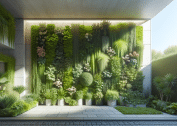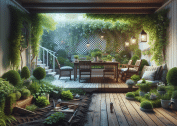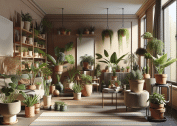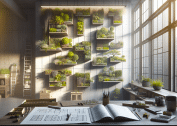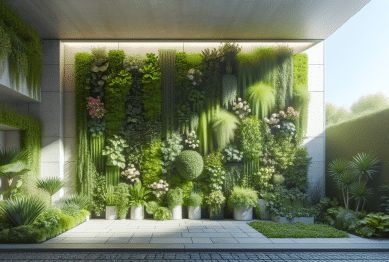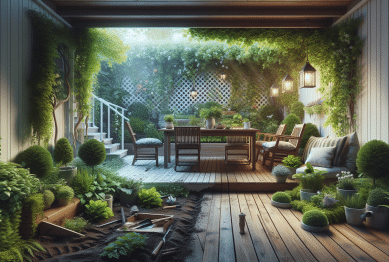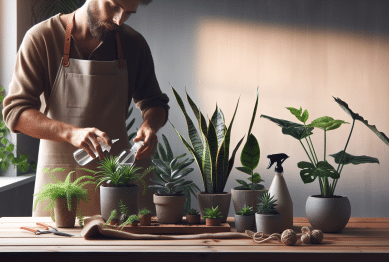Unlock the secrets to designing a relaxing, functional, and beautiful backyard space without overspending. Explore expert-approved landscaping ideas, native plant selection, sustainable lawn tips, and creative outdoor living solutions that boost your comfort and elevate home value—all optimized for your needs and today’s trends.
How a Thoughtful Backyard Design Boosts Enjoyment and Home Value
Designing a backyard isn’t just about aesthetics—careful planning transforms underutilized spaces into inviting retreats where socializing and relaxation come naturally. Landscape designers consistently emphasize the importance of functional flow and visual appeal, as both can greatly boost not just daily enjoyment but also the long-term value of your home. For example, even modest changes like improved pathways or centralized seating areas can make a big difference in how a space feels and operates throughout the year (Source: https://www.hgtv.com/outdoors/outdoor-spaces/landscaping-and-hardscaping/landscaping-and-homes-value).
A core principle in backyard renovation is the integration of both shade and sun areas. Whether it’s through the addition of pergolas, small trees, or patio umbrellas, providing protection from the elements invites greater use regardless of the weather. According to landscaping experts, effectively placing trees and structures can also lower home cooling costs in summer and increase privacy—a winning combination for property owners focused on value and enjoyment.
This sense of purpose-driven design helps the outdoor area to become a true extension of indoor living space. Features like fire pits, or simple decks, when planned alongside pathways and plant beds, encourage more time spent outdoors. A thoughtful approach, considering how traffic flows from the house into the yard, makes entertaining and everyday use much easier—highlighting why design details are so critical for transforming backyard spaces.
Choosing Native Plants for Low-Maintenance Landscaping
Many homeowners seek a lush, beautiful garden but want to avoid extensive yard care. This makes native plant selection one of the smartest strategies for easy-going and environmentally friendly landscaping. Native plants are specifically adapted to local soil, sunlight, and rainfall conditions, which means they typically need less water and fertilizer compared to exotic varieties (Source: https://www.epa.gov/greenscapes/greenscapes-planting-native-plants).
Choosing plants that thrive naturally in your region supports biodiversity and can attract helpful pollinators like bees and butterflies. There’s also a financial benefit—reduced lawn maintenance costs over time. Public gardens and university extension programs often publish region-specific guides to native plants, making it easier to find hardy flowers, shrubs, and ground covers for every type of yard.
Once native plants are established, they often require little to no irrigation beyond natural rainfall. This makes them an ideal choice for drought-prone areas or for anyone interested in reducing their garden’s environmental impact. By focusing on smart plant selection from the start, you can create a colorful, resilient landscape that supports local wildlife and looks appealing year-round.
Sustainable Lawn Care and Natural Alternatives
Sustainability is a growing trend in backyard landscaping, with many residents aiming for water-wise lawns and reduced chemical use. Techniques such as rainwater harvesting, mulching, and composting grass clippings can dramatically increase a lawn’s resilience while decreasing dependency on fertilizers and synthetic products (Source: https://www.epa.gov/soakuptherain/soak-rain-rain-gardens).
Alternatives to traditional grass lawns are gaining traction, especially ground covers like clover, creeping thyme, and moss. These options need far less watering and mowing than standard turf, and they stay green longer during dry spells. Experts recommend combining mulch, permeable paving, and naturalistic plant groupings to ensure good drainage and vibrant visual appeal in any climate.
For those who still prefer classic lawns, transitioning to drought-tolerant grass varieties—like fescue or buffalo grass—can provide aesthetic benefits and resilience. By rethinking the role of the lawn and considering sections of ornamental grass, wildflower meadows, or no-mow areas, homeowners can boost beauty while protecting the environment—and their budget.
Creative Outdoor Living Spaces for Every Budget
Transforming your yard doesn’t require a massive investment. Simple upgrades—like adding a gravel patio with string lights, a cozy bench under a tree, or a compact raised garden bed—can create inviting spaces that reflect personal style. Modular outdoor furniture, shade sails, and versatile fire bowls allow for flexibility, so you can enjoy the outdoors in multiple seasons.
Lighting is often overlooked but makes a real difference in how a backyard is used after sunset. Solar stakes, LED string lights, or lanterns boost safety and ambiance, making the space feel welcoming for dinners or gatherings. Even if your yard is small, vertical gardening and fold-down tables expand usable space without the need for costly construction projects.
Container gardening is another trend—perfect for renters or those with limited ground. Pots brimming with herbs, flowers, or small vegetables can brighten patios and decks while offering a practical harvest. These approachable ideas help anyone transform an ordinary yard into a lively, customized oasis, no matter the budget or space size.
Water Features and Wildlife-Friendly Add-Ons
Even small water features like birdbaths, basin fountains, or tiny ponds can dramatically change the sound and feel of a garden. The gentle splash of water not only invites calm but also attracts songbirds and other wildlife—creating an ecosystem that brings extra interest to your yard (Source: https://www.audubon.org/news/how-make-your-yard-bird-friendly).
To support more nature, consider planting berry bushes, installing birdhouses, or setting up pollinator habitats tailored for butterflies and bees. Garden organizations provide templates and advice for creating safe havens that contribute to local biodiversity, making your backyard both visually pleasing and ecologically meaningful. Integrated design ensures features enhance rather than disrupt your routine outdoor use.
Low-maintenance ponds or recirculating fountains are increasingly popular due to improved, energy-efficient pumps that require minimal upkeep. When planning such add-ons, it’s important to choose native aquatic plants and safe water treatments that support a thriving ecosystem without burdening you with cleaning duties. These enhancements can turn even humble yards into dynamic environments full of life.
Smart Technology and Eco-Friendly Upgrades
Today’s backyard upgrades often marry sustainability with simple tech. Solar-powered lighting, smart irrigation controllers, and weather-sensing sprinkler systems save energy and water while keeping landscapes vibrant (Source: https://www.energy.gov/energysaver/articles/landscaping-energy-efficient-homes).
Robotic lawnmowers and programmable outdoor lighting help streamline weekly chores and improve efficiency, allowing more free time to relax outdoors. Battery-powered tools and automatic composters further minimize environmental impact and make yard maintenance accessible even to beginners.
With resources like cooperative extension services or home improvement guides, learning about rebates and incentives offered for eco-friendly landscape projects is easier than ever. Adopting emerging technologies ensures your backyard is both future-ready and gentle on the planet—offering a blend of comfort, convenience, and sustainability for homeowners and renters alike.
References
1. HGTV. (2021). Landscaping and Home Value. Retrieved from https://www.hgtv.com/outdoors/outdoor-spaces/landscaping-and-hardscaping/landscaping-and-homes-value
2. U.S. Environmental Protection Agency. (2023). Greenscaping: Planting Native Plants. Retrieved from https://www.epa.gov/greenscapes/greenscapes-planting-native-plants
3. U.S. Environmental Protection Agency. (2022). Soak Up the Rain: Rain Gardens. Retrieved from https://www.epa.gov/soakuptherain/soak-rain-rain-gardens
4. Audubon Society. (2019). How to Make Your Yard Bird-Friendly. Retrieved from https://www.audubon.org/news/how-make-your-yard-bird-friendly
5. U.S. Department of Energy. (2021). Landscaping for Energy-Efficient Homes. Retrieved from https://www.energy.gov/energysaver/articles/landscaping-energy-efficient-homes
6. University of Minnesota Extension. (2023). Native Plant Gardening. Retrieved from https://extension.umn.edu/planting-and-growing-guides/native-plant-gardening


